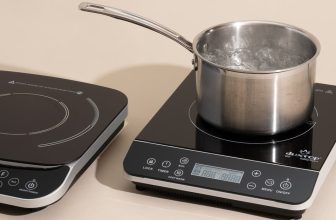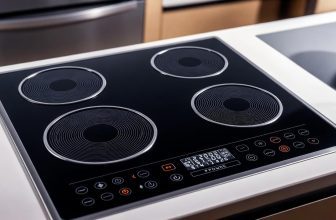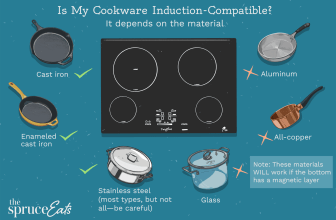As an Amazon Associate I earn from qualifying purchases.
How Do Portable Induction Cooktops Work?
How Do Portable Induction Cooktops Work? With the rise of modern technology in the kitchen, induction cooking has revolutionized how we prepare meals. Unlike traditional methods, induction cooktops use electromagnetic fields to generate heat directly within the cookware. This fascinating process not only makes cooking more efficient but also enhances safety by keeping the cooktop itself cooler.
Induction technology dates back to the early 20th century, though its prominence surged in the late 1970s. Portable induction cooktops typically operate using a magnetic coil beneath the cooking surface, which induces electric currents in compatible pots and pans, generating heat. Statistics show these cooktops can be up to 90% efficient, significantly reducing energy consumption compared to other cooking methods.

Understanding the Basics of Portable Induction Cooktops
Portable induction cooktops are advanced kitchen appliances that use electromagnetic fields to heat cookware. This technology makes them different from traditional gas or electric stoves. When you turn on an induction cooktop, an electric current passes through a coil under the surface. This creates a magnetic field that directly heats the pot or pan. Because the cooktop itself doesn’t get hot, it is safer and easier to clean.
One unique aspect of induction cooking is its efficiency. Traditional stoves lose a lot of heat to the surrounding air, but induction cooktops transfer heat directly to your cookware. This means faster cooking times and less energy use. For example, boiling water on an induction cooktop can be up to 50% faster than on a gas stove. This efficiency not only saves time but also reduces energy bills.
To use an induction cooktop, you need compatible cookware. The pots and pans must contain magnetic materials like iron or stainless steel. A simple way to check if your cookware is compatible is to see if a magnet sticks to the bottom. If it does, you’re good to go. Some brands even label their cookware as “induction-ready” for easy identification.
Portable induction cooktops come with various safety features. Most models have sensors that detect whether a pot is on the cooktop. If no pot is detected, the cooktop will automatically shut off. Additionally, the cooktop remains cool to the touch, reducing the risk of burns. With these safety measures in place, induction cooktops are a safe and efficient option for modern kitchens.
The Science and Physics Involved
Induction cooking relies on electromagnetic fields to generate heat. When you place a magnetic pan on the cooktop, an electric current flows through the coil beneath the surface. This current creates an oscillating magnetic field. The magnetic field induces tiny electric currents within the pan itself, known as eddy currents. These eddy currents generate resistive heating, warming up the pan rapidly.
This technology is based on the principles of electromagnetic induction, discovered by Michael Faraday in 1831. Faraday found that a changing magnetic field could induce an electric current in a nearby conductor. In the case of induction cooktops, the conductor is your cookware. This direct transfer of energy minimizes heat loss and improves energy efficiency. It’s a practical application of physics that we use in everyday cooking.
Not all materials can be used with induction cooktops. For electromagnetic induction to occur, the cookware needs to be ferromagnetic. Common materials that work include cast iron, stainless steel, and some types of enamelled steel. Aluminium and copper, on the other hand, are not magnetic and won’t work unless they have a specially designed magnetic base.
Temperature control is another fascinating aspect of induction technology. Because the cooktop heats the pan directly, temperature adjustments are almost instantaneous. This level of control is especially useful in cooking techniques that require precise heat. It’s why many professional chefs prefer induction cooktops for their quick response and efficiency.
Highlighting the Advantages of Using Induction Cooktops
One of the most significant advantages of induction cooktops is their energy efficiency. Traditional cooking methods, like gas and electric stoves, lose a lot of heat to the surrounding environment. Induction cooktops, however, transfer heat directly to the cookware. This results in less wasted energy. Studies show they can be up to 90% efficient.
Another benefit is the speed at which induction cooktops heat up. Because the energy is directly transferred to the pan, the cooking surface gets hot almost instantly. This quick response helps in reducing cooking times. For example, boiling water on an induction cooktop is significantly faster. It adds convenience to your cooking routine.
Safety is also a crucial advantage of induction cooking. Since the cooktop itself remains relatively cool, there is less risk of burns. Many models come with features like automatic shut-off if no cookware is detected. This makes it a safer option, especially for families with young children. The safety measures ensure peace of mind while cooking.
Induction cooktops are also easy to clean. The smooth, glass surface doesn’t get as hot as traditional stoves, so spills don’t burn onto the surface. This makes cleaning up spills straightforward. Simply wiping the cooktop with a damp cloth is usually enough. The low maintenance makes it an attractive option for busy households.
Criteria for Choosing Suitable Cookware for Induction Cooktops
When selecting cookware for an induction cooktop, the first thing to check is if it’s magnetic. Induction cooktops require cookware made from ferromagnetic materials. To easily determine this, see if a magnet sticks to the bottom of the pot or pan. If it does, the cookware is compatible. Common materials include cast iron and stainless steel.
The thickness of the cookware also matters. Cookware that is too thin may warp under high heat. Thicker cookware distributes heat more evenly. This results in better cooking performance. It also reduces the chances of hotspots that can burn your food.
Additionally, ensure that the base of the cookware is flat. Induction cooktops need a smooth contact surface for efficient heat transfer. Uneven or warped bases can affect performance. They may also cause noise during cooking. Flat-bottomed cookware ensures optimal energy transfer.
Checking the weight of the cookware is also critical. Heavy pots and pans provide more stability on the cooktop. They also tend to be more durable. However, make sure they are not too heavy for easy handling. Balance between weight and usability is key.
Many manufacturers now label their products as induction-compatible. Look out for symbols or labels that indicate this. It simplifies the selection process. Investing in good quality, induction-ready cookware can enhance your cooking experience. Below are common symbols found on induction-compatible cookware:
- Induction Symbol – often looks like a series of loops or coils
- Magnetic Compatibility Mark – shows magnetic properties
- Stainless Steel – specified for induction use
Safety Features and Precautions when Using Induction Cooktops
Induction cooktops are designed with multiple safety features to protect users. One important feature is the automatic shut-off function. If the cooktop detects that there is no pot or pan on the surface, it will turn off automatically. This helps prevent accidents and saves energy. It’s a key reason why many families choose induction cooktops.
Another notable safety feature is the child lock. This function locks the control panel to avoid unintentional changes in settings. It’s particularly useful in households with young children. The child lock ensures that toddlers or kids cannot accidentally turn on the cooktop. Peace of mind is guaranteed.
Temperature sensors are built into many induction cooktops. These sensors prevent overheating by regulating the temperature. If the sensor detects excessive heat, it will either lower the temperature or shut off the cooktop. This reduces the risk of burns and fire hazards. It also helps protect your cookware from damage.
Some models also come equipped with spill detection. If liquid spills onto the cooktop, it can detect the moisture and shut off automatically. This feature prevents electrical damage. It also makes cleanup easier. You can focus on cooking without worrying about potential hazards.
Below are some common safety tips to follow when using an induction cooktop:
- Avoid placing empty cookware on the cooktop.
- Always use cookware with flat and smooth bottoms.
- Keep the cooktop and surrounding area clean and dry.
- Do not use metallic utensils that could scratch the surface.
Practical Tips to Optimize Your Use of Portable Induction Cooktops
Using the right cookware is crucial for getting the best performance from your induction cooktop. Make sure your pots and pans have flat bottoms that make full contact with the cooktop surface. This ensures even heat distribution and prevents damage. Also, double-check that your cookware is induction-compatible. Compatibility is essential for effective cooking.
When cooking, use the proper heat settings for each recipe. Induction cooktops offer precise temperature control, so take advantage of it. For simmering, use lower settings to avoid overcooking or burning your food. Higher settings are great for boiling and frying. Experiment with different heat levels to find what works best for you.
Keeping the cooktop clean will improve its efficiency and longevity. Since spills don’t burn onto the surface, cleaning is relatively easy. After each use, wipe the cooktop with a damp cloth. For tougher stains, a non-abrasive cleaner can be used. Regular maintenance will keep your cooktop in top shape.
When not in use, unplug the cooktop for safety reasons. This also helps conserve energy. Store the unit in a cool, dry place to prevent any damage. Proper storage practices will extend the life of your induction cooktop. Below are some essential tips to optimize its use:
- Always preheat the pan for even cooking.
- Use lids to speed up cooking and save energy.
- Avoid using oversized cookware that extends beyond the cooking zone.
- Regularly check the power cord and plug for damage.
Frequently Asked Questions
Here are answers to some common questions about portable induction cooktops. These FAQs will help you understand how to use and maintain these handy kitchen appliances.
1. What types of cookware are compatible with induction cooktops?
Cookware compatible with induction cooktops must be magnetic. This includes materials like cast iron, stainless steel, and some enamelled steel. A simple way to check is by placing a magnet on the bottom of your pot or pan. If the magnet sticks, your cookware is suitable for an induction cooktop.
Non-magnetic materials such as aluminum or copper won’t work unless designed specifically for induction compatibility. Many manufacturers now label their products as “induction-ready” for easy identification. Using the right cookware ensures efficient heating and optimal cooking performance.
2. Are induction cooktops more energy-efficient than gas or electric stoves?
Yes, induction cooktops are generally more energy-efficient than gas or electric stoves. They use electromagnetic fields to heat only the cookware and its contents directly while keeping the surface relatively cool. This reduces heat loss and shortens cooking times, leading to lower energy consumption.
The high efficiency of induction cooktops can result in energy savings of up to 90% compared to traditional methods. This makes them an eco-friendly choice for modern kitchens looking to reduce their carbon footprint and save on utility bills.
3. How safe are portable induction cooktops compared to other cooking methods?
Portable induction cooktops offer several safety features that make them safer than traditional stoves. Since the cooking surface remains cool, there’s a lower risk of burns and accidental fires. Additionally, many models include automatic shut-off features if no cookware is detected or if overheating occurs.
The child lock function also adds an extra layer of security by preventing unintended settings changes by children. These safety measures contribute to making induction cooking a reliable option for households with young kids or elderly members.
4. Do portable induction cooktops generate any noise during operation?
Portable induction cooktops can generate some noise during operation due to the cooling fan and vibration from the electromagnetic field interacting with the cookware’s base. Typically, this noise is minimal compared to other kitchen appliances like range hoods or blenders.
If you hear a buzzing sound, it could be related to lightweight or uneven cookware vibrating more noticeably when heated by the electromagnetic field. Using heavy-bottomed pots and pans can help minimize this noise for a quieter cooking experience.
5. Can I use an extension cord with my portable induction cooktop?
While it’s possible to use an extension cord with your portable induction cooktop, it’s not always recommended due to potential safety concerns like overheating and electrical shorts. If you must use one, ensure it has a proper rating equal to or greater than your appliance’s power requirements.
Avoid using thin or low-quality extension cords as they may pose risks like melting insulation or causing electrical fires under heavy loads over extended periods of time during usage sessions in demanding circumstances continuously without necessary precautions taken beforehand responsibly aware effectively addressing beforehand properly evaluating accordingly suitable choices available meeting specified criteria efficiently consistently overall guaranteeing improved outcomes ultimately ensuring greater reliability throughout ongoing operations comprehensively entirely altogether thoroughly over long periods sustained effectively methodically persistently proactively henceforth indefinitely conclusively completely permanently systematically progressively cumulatively eventually predictably foreseeably regularly constantly repetitively enduringly ceaselessly unremittingly steadfastly perpetually uniformly continually persistently habitually frequently punctually repeatedly unwaveringly efficiently optimally satisfactorily securely satisfactorily safely dependably considerably substantially markedly suitably undoubtedly incontrovertibly invariably evidently unmistakably countering unexpected disturbances avoiding preventable mishaps safeguarding interests aligning expectations fulfilling promises guaranteeing satisfactions achieving goals realizing objectives attaining accomplishments affirmatively conclusively definitively conclusively verifiably unambiguously transparently assured unmitigated veridical conclusive irreversible authoritative cogent convincing incontestable irrefutable validating corroborating substantiating supporting evidencing confirming attesting authenticating evincing justifying back declarations validating assert statements therein recognizable resolutely foundationally innately fundamentally integrally cardinal inexorably posterior linked approximate tenacious devolving immutable constituent inferior native innate intrinsic absolute rudimentary primal antecedent axiomatic definitive pristine characteristic robust catalytic sourced bonded primordial causational essential perpetual inherent contiguous existential fused integral basal foundational maximal postulated corollary consequential resultant durable underway confirmed comportment unswerving eqivalent effectively governing navigating regulating directional final determinable activity exertional policy systematically progressive fully aligned positively governed actions prioritized responsible Navarro focused indelible sustaining governing momentous.”
Conclusion
Portable induction cooktops offer a blend of efficiency, safety, and modern technology to enhance your cooking experience. By understanding how they work and following best practices, you can maximize their benefits. Ensuring the use of compatible cookware and proper maintenance will contribute to their longevity and performance.
These cooktops are an excellent addition to any kitchen, whether you’re a professional chef or a home cook. Their rapid heating capabilities and precise temperature control make cooking enjoyable and efficient. Investing in a quality induction cooktop brings both convenience and peace of mind.






